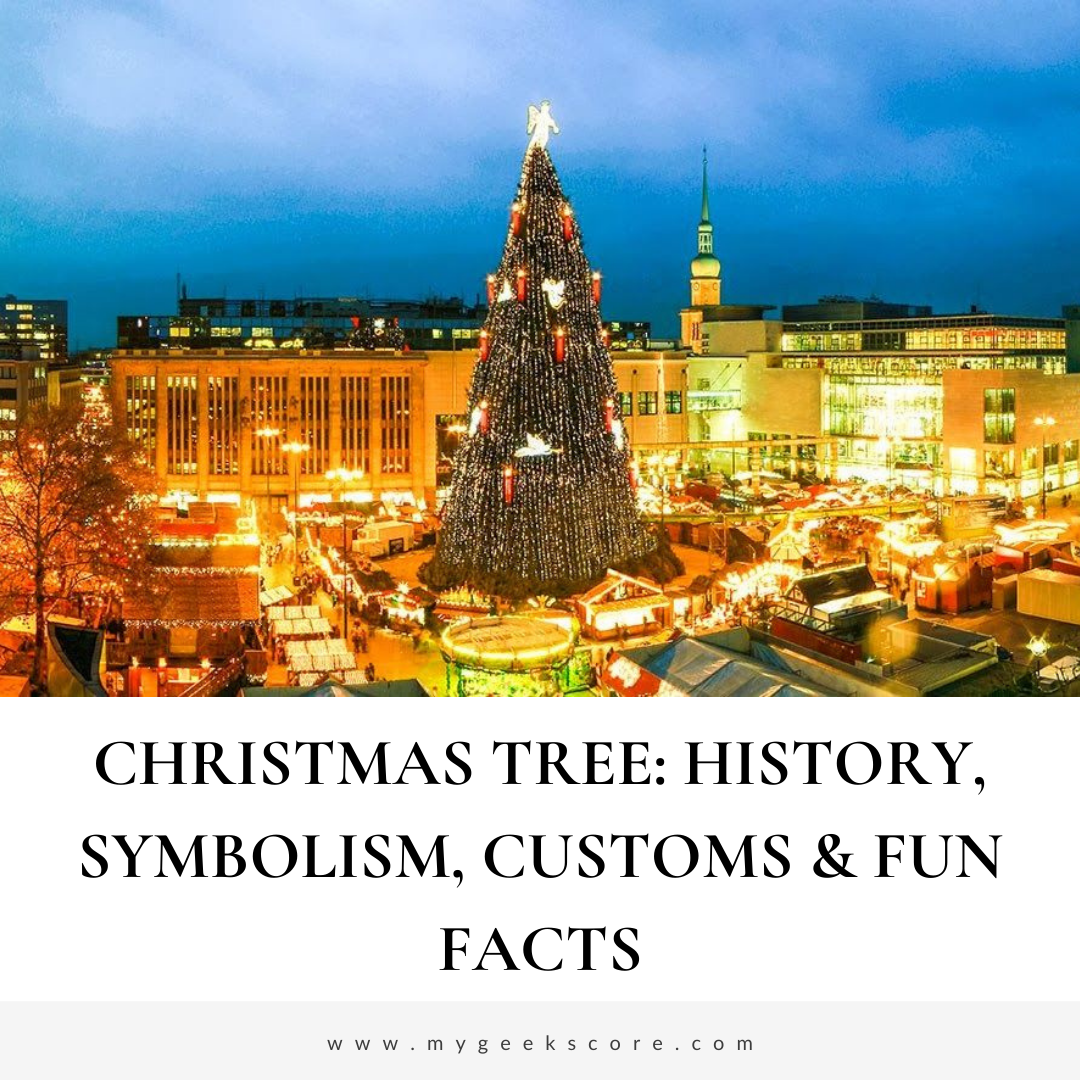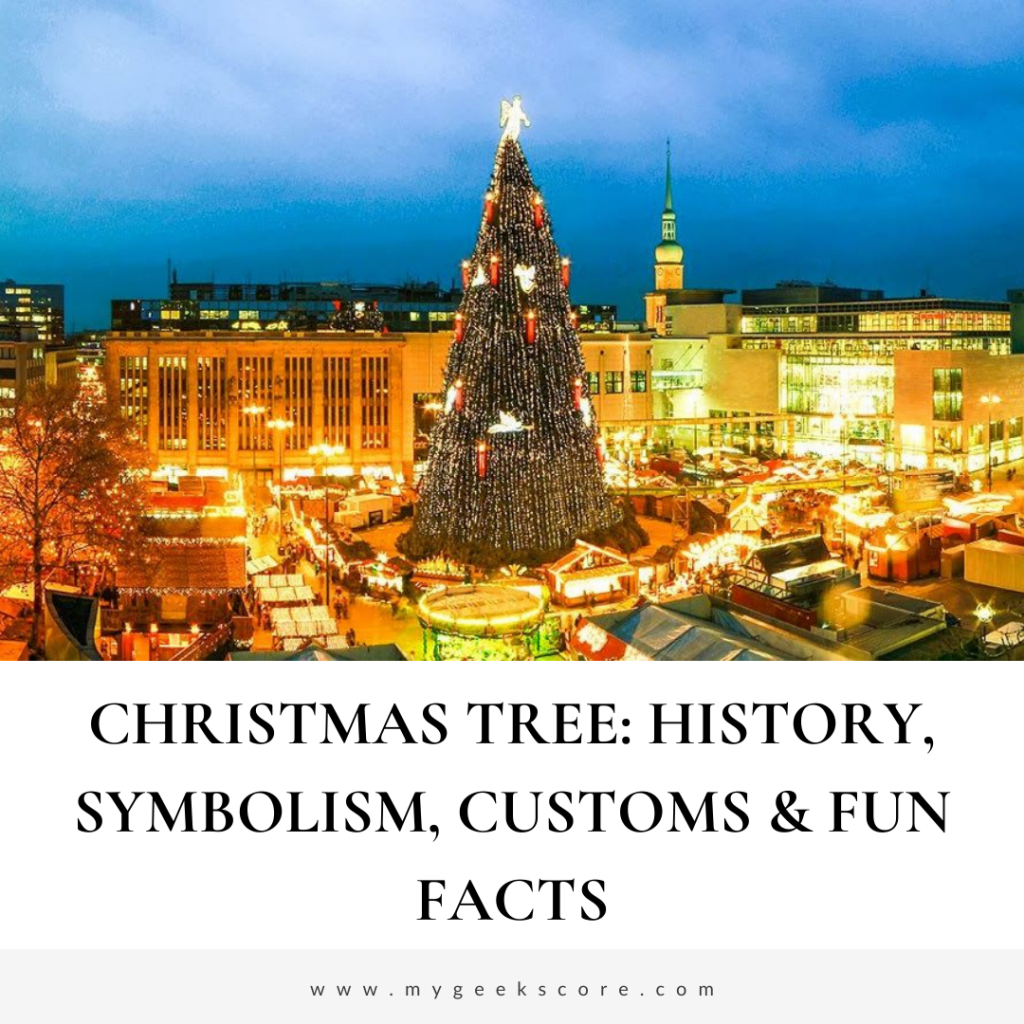Christmas Tree: History, Symbolism, Customs & Fun Facts


My Geek Score: When we think about a Christmas tree, we usually envision a decorated evergreen plant in the corner of the living room. But there’s much more to this tradition that will be discussed further.
The history of Christmas trees goes back many centuries and is filled with fascinating tales worldwide. This article will explore how Christmas trees have evolved in history, their meanings and uses throughout the ages, and their role in modern traditions today.
History Behind Christmas Tree
The history behind Christmas tree is a long and rich one, and it has been a part of many cultures. It is as long and diverse as its colorful decorations. Tallinn and Riga, two cities in Estonia and Latvia, respectively, started the tradition of Christmas trees.
They both put up trees in the city square, claiming they had the first trees. Tallinn’s ‘Tree of Wonder’ was planted in 1441, while Riga’s first ‘Christmas tree’ was erected in 1510.
Foreigners and local unmarried men who were merchants, ship owners, or members of the Brotherhood of Blackheads in Livonia (now Estonia and Latvia) brought decorated trees to celebrate Christmas.
The trees were considered symbols of fertility and prosperity. They also held elaborate decorations on trees that reached the ceilings of town guild halls.
There is another story passed down through the years that Martin Luther, who started the Protestant Reformation, is responsible for bringing Christmas trees into homes during the sparkling festival of Christmas when Jesus Christ was born in a stable.
One night, Luther was reminded of Jesus on a walk through the forest; when he looked up at the sky above, he could see the shining and sparkling stars, and the reflection was seeping through the branches.
And this sight inspired him to bring a tree into his house and decorate it with candles and ornaments to honor the beauty of the starry night sky. As a result, it then grew in popularity in English-speaking countries.
Another story associated with the Christmas tree is that a forester and his family lived once upon a time. They were financially inferior and only had one tiny room in their cottage to live in.
One evening, while they were in bed, the forester was awoken by a knock on the door. After the forester answered a knock, he found a lost little boy standing there cold and terrified.
The family took the boy in and looked after him. The following day when they woke up, they found that the little boy had turned into Jesus Christ.
Jesus gave them a branch of Fir Tree as a present for looking after him, and it became a tradition for people to have Christmas trees in their houses ever since!
What does a Christmas Tree Symbolize?
The Christmas tree symbolizes Christianity, Christmas time, and the holiday season since it contains all the elements that signify the importance of Christmas.
The star at the top of the Christmas tree represents the very star of Bethlehem that led the three wise men to the place where Jesus, our savior, was born.
The bells, candy cane, drums, and cotton, which give the feel of snow, all hold important and relevant meanings for the festival.
Trees were a part of pre-Christian cultures from all over Europe, where people worshiped them in the name of their gods. But when Christianity came along, it was decided by the Church that only evergreens should be used to symbolize everlasting life, while deciduous trees should represent eternal death and rebirth.
Among these evergreen trees, the Fir Tree was believed to be symbolic of new life.
What are the Different Customs Associated with Christmas Trees?
Many interesting facts and customs have evolved around the Christmas tree over time as traditions go. Let’s take a look at a few:
• Many people have the tradition of putting a small plant or branch of the (cheery or hawthorn plant) into a container and bringing it into their house to have it blossom at Christmas.
•Another tradition came forward where people made pyramids of woods and decorated them with simple fruits like apples and oranges as they weren’t wealthy and couldn’t afford an actual plant. This pattern continued through the years, and many legends explain the significance of the Christmas Tree.
• By the mid-1800s, Christmas tree decorations became more acceptable in many German homes. It was fashionable for people to have a Christmas tree out of nature and a nativity scene underneath it.
Fun Facts About Christmas Tree
• Germany and England brought the first trees into homes in the mid-1500s. They weren’t cut from the forest but came from gardens or hedges, which is where we get the term “Christmas tree” as they looked like Christmas trees in people’s gardens.
• Decorating the Christmas tree became more popular in England in the 1840s when Prince Albert brought many German traditions to the English court. The British people loved this idea of bringing greenery into their homes, and by 1841, Queen Victoria was getting a Christmas tree. Soon everyone wanted one just like her’s, and so began the tradition of bringing home a tree to decorate for Christmas.
• For centuries, Christmas trees have been synonymous with the celebration of Christ’s birth. And I know it would be hard to believe, the Christmas tree is older than Christianity. It came from pre-Christian Germanic folklore, where people worshipped nature gods and spirits — or even trees! The idea was to supply people with symbols of the power believed to live in objects like trees.
Conclusion
The Christmas tree’s history is a very long and vivid one but still has few secrets. And looking back on the history of the Christmas tree, it is clear that this symbol of Christmas has been a part of people’s lives for more than thousands of years.
It has evolved and changed with time and grown its importance. And no matter how you celebrate Christmas, the most important thing about Christmas is what it represents at the end of the day and how we perceive its meaning.









3 thoughts on “Christmas Tree: History, Symbolism, Customs & Fun Facts”